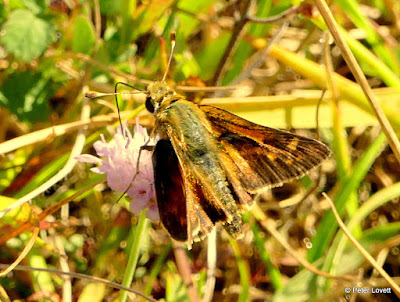A wonderful hour and a half was spent walking over the hill photographing wildlife this afternoon.
Above and below a Silver-spotted Skipper.
Click on any picture to expand it.
Female Meadow brown also on a Scabius flower.
Hundreds of Field Grasshoppers were hopping and flying around
Two Field grasshoppers
Female Common blue butterfly on "The Pride of Sussex", the county flower of Sussex or is it?. Pete Beard in comments below suggests a Brown Argus. Thanks Pete you are probably correct: this is such a learning curve!
Wall butterfly.
Chalkhill blue.
The view looking westwards.
Chalkhill blue.
Above might be a Hill Cuckoo Bee, or Red-tailed Cuckoo Bee, Bombus rupestris looking at the short hairs on the legs.
Small heath butterfly.
Take a look at http://www.wolstonbury.com/ if you are interested to help in conservation work.
For illustrated talks on natural history and history see www.peterlovetttalks.co.uk
For illustrated talks on natural history and history click here for www.peterlovetttalks.co.uk
Friday, 17 August 2018
Thursday, 2 August 2018
Butterflies and other wildlife of Sussex on Wolstonbury Hill, 1 August 2018
The wind made photographing flowers and butterflies somewhat tricky on 1st August 2018. The bright sunshine brought butterflies, grasshoppers and bees out in good numbers.
This is the view from near the top looking westwards.
On the way up in the far distance is the spire of Cuckfield Holy Trinity church with the village of Hurstpierpoint in the foreground
Along the woodland edges Speckled Woods were common.
Scabious attracted many insects including a hover fly, above, bees and Silver-spotted Skippers as below.
A fly.
The "Pride of Sussex" the county flower was abundant.
Gatekeeper.
Chalk Hill Blues were flying in good numbers too together with Common Blues.
Buzzards "mewed" overhead.
Above and below Bombus sylvestris, the parasitic Forest Cuckoo Bee
A solitary Wall butterfly was seen, above.
Silver-spotted Skippers.
Common Blue butterflies: female above and male below.
Above, a mature Stripe-winged Grasshopper, Stenobothrus lineatus
Spectacularly there were four Kestrels flying around the hill at the same time.
Looking eastwards towards Jack and Jill windmills, https://www.jillwindmill.org.uk/ and the meadow, which the Friends of Wolstonbury, www.wolstonbury.com have created by clearing the woodland over the years to create a uniquely diverse habitat rich in plants and insect species. There is much more conservation work to be done than the Friends of Wolstonbury can tackle. If such work appeals to you, come and join us: new volunteers are welcomed and much needed.
See also www.peterlovettwalks.eu for guided walks.
This is the view from near the top looking westwards.
On the way up in the far distance is the spire of Cuckfield Holy Trinity church with the village of Hurstpierpoint in the foreground
Along the woodland edges Speckled Woods were common.
Scabious attracted many insects including a hover fly, above, bees and Silver-spotted Skippers as below.
A fly.
The "Pride of Sussex" the county flower was abundant.
Gatekeeper.
Chalk Hill Blues were flying in good numbers too together with Common Blues.
 |
| Chalk Hill Blue |
Buzzards "mewed" overhead.
 |
| Common Blue |
Above and below Bombus sylvestris, the parasitic Forest Cuckoo Bee
A solitary Wall butterfly was seen, above.
 |
| Chalk Hill Blue |
 |
| "The Pride of Sussex" |
 |
| Forest Cuckoo Bee |
 |
| Silver-spotted Skipper |
Silver-spotted Skippers.
Common Blue butterflies: female above and male below.
Above, a mature Stripe-winged Grasshopper, Stenobothrus lineatus
Spectacularly there were four Kestrels flying around the hill at the same time.
Looking eastwards towards Jack and Jill windmills, https://www.jillwindmill.org.uk/ and the meadow, which the Friends of Wolstonbury, www.wolstonbury.com have created by clearing the woodland over the years to create a uniquely diverse habitat rich in plants and insect species. There is much more conservation work to be done than the Friends of Wolstonbury can tackle. If such work appeals to you, come and join us: new volunteers are welcomed and much needed.
See also www.peterlovettwalks.eu for guided walks.
Subscribe to:
Comments (Atom)














































